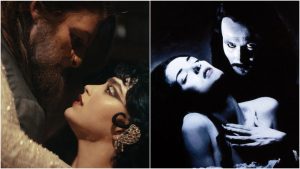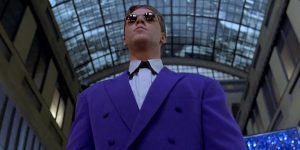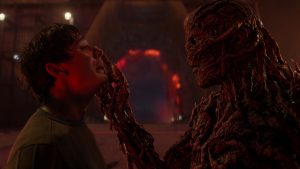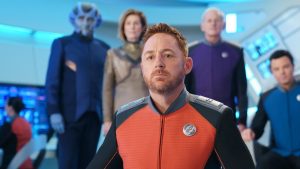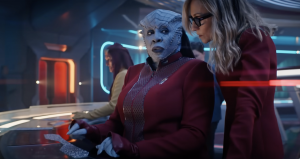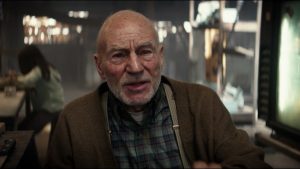
During the filming of director Wes Craven’s A Nightmare on Elm Street amid the summer of 1984, Freddy Krueger performer Robert Englund wasn’t just creating a boogeyman that would linger for audiences four decades later… he was making something that would haunt him too. One night while Englund was shooting the infamous front yard scene with actress Heather Langencamp late at night, the actor had a break around four in the morning. She decided to take some rest on a cot in his dressing room when…
“They knocked on my door and they go, ‘Robert, Robert, we’re going to try to get this shot with you and Heather before the sun comes up,’” Englund tells us 40 years after the fact. “The only light in the room was around my makeup mirror, dimmed down to halfway. There was a little ghostly light, and I swung out of my cot and looked, and there—buried deep in the mirror—was this deformed, bald, disfigured old man. I went like that [jolts back], and the creature in the mirror went like that. Then I realized, ‘Oh my God, it’s me!’ But for those few seconds when I first awoke, I had that bitter taste in the mouth from sleep, and I was disoriented, still one foot in my subconscious. And that memory of that other man that I didn’t realize was me buried in the mirror, I still return to that a couple times a year. That’ll show up in a dream or something, because it was so disorienting. It obviously made a little crease in what’s left of my brain.”
langenkamp, who appeared with Englund in that iconic movie, as well as the third and seventh installments of the franchise, also experiences “full blown nightmares about Robert chasing me, and that giant tongue wrapped around my head. I have very visceral dreams of that.”
This is a testament to the power of the imagery Wes Craven was tapping into with A Nightmare on Elm Street, which followed four teenagers who become threatened by Freddy Krueger, a disfigured monster with a clawed hand. And despite being only a figment of their dreams, this fiend in the red and green sweater was able to hurt and kill them in the real world too.
Although it was initially a hard sell for the writer/director as well as producer Robert Shaye—whose distribution outfit New Line Cinema eventually ponied up the entire $1.8 million budget themselves—the movie tapped into something in the zeitgeist, becoming one of the biggest horror entries of the ‘80s with over $57 million in returns. The original Elm Street (and its six ensuing sequels) also turned New Line into a mini-major dubbed “the house that Freddy built,” transforming Englund into a slasher icon in the process.
We had the chance to chat with Englund and Langenkamp during the run-up to the 40th anniversary release of the original film, now available for purchase digitally and on 4K Blu-ray on Oct. 15, with an “unrated version” included in the special features. And one of the things we touched on with the two actors is the ability of the Elm Street series to tap into common subconscious dream archetypes. According to Englund and Langenkamp, fans come up still from around the world to talk about how the imagery of the 1984 classic speaks to their own nightmares.
“Running up the stairs and having the feet sink into the stairway, into the goo, is—bizarrely—one of the dreams that so many people have related to me,” admits Langenkamp. “It was the one that Bob Shaye, our producer, insisted that we shoot, because that was one of his recurring nightmares. People really love that, and I always thought it was silly and kind of a throwaway part of that scene.”
Englund adds, “In Part 4 there’s a sequence with Lisa Wilcox where she leaves the diner with her boyfriend to get in a pickup truck, and it begins a continuous loop. She’s back in the diner, she locks up [the door], and leaves again. They get in the truck, they start to drive, and they look at each other, ‘Have we been here before?’ Then she’s back in the diner, putting a menu away, wiping the counter, locking up, and they’re getting in the truck… and it loops like that. That, for me, is as close to the kind of things that happen in my nightmares that are just so frustrating, you know? I still have recurring loops from the actor’s nightmare of forgetting your dialogue, or not studying for that algebra test.”
While Freddy has been the catalyst for many a bad dream since 1984, what informed the performance prior to that? According to Englund it was a little bit of Klaus Kinski’s portrayal of the title character in Werner Herzog’s Nosferatu the Vampyre, as well as a much more obscure performance in Englund’s own back catalog: the 1979 made-for-TV thriller Mind Over Murder.
“I did a TV movie with a very popular actress of the time named Deborah Raffin and the wonderful Bruce Davidson, but the villain in this movie was Andrew Prine,” Englund remembers. “I’d worked with Andrew Prine on a television series, he’s a wonderful actor and has some great Broadway credits, but Andrew was the villain in this movie. There’s a plane going down that’s been bombed by terrorists. You cut to Andrew Prine, who has shaved his head for the role, and he touched his bald head a lot. He was the serial killer, the terrorist, but I was in that movie and I remember watching him do that. I think subconsciously that me watching Andrew playing that strange psycho may have informed Freddy a little bit.”
While Englund had been making movies and television for a decade by the time he got to Elm Street, Langenkamp had only had some minor deleted roles in Francis Ford Coppola’s The Outsiders and Rumble Fish (both shot in Tulsa, Oklahoma) before she was suddenly a Hollywood lead as Nancy in Craven’s horror masterpiece.
“In Tulsa, I met Janet Hirshenson,” Langenkamp says. “She was the casting director of The Outsiders along with Jane Jenkins, but I really saw Janet a lot. When I got my SAG card, I came to Los Angeles and Janet was so generous. She let me sleep on her couch and helped me find an agent, helped me go out on auditions. By the time I got Nightmare on Elm Street, she had really set me up and helped me get my foot in the door here in Hollywood. I really owe so much to her. They were just amazing people.”
Langenkamp adds, “My first car was Jane Jenkins’ son’s car that I bought off of him because I needed a car. They had a very generous spirit about helping people from out of town who were coming from long places. My dad was so worried about me he said, ‘I’m coming to Hollywood,’ and I said, ‘Well, you’re gonna have to meet Janet.’ So she went to dinner with us and allayed my dad’s fears like I was going to, you know, get involved with some kind of slasher. [Laughs]”
One of the hallmarks of the first Nightmare on Elm Street is how sympathetic the teenage characters are, especially when most of the adult characters disbelieve (a la Ronee Blakley as Nancy’s mom) or even use them, as Nancy’s cop dad (John Saxon) does to apprehend her friend Rod (Nick Corri). Perhaps the only adult sympathetic to the plight of Langenkamp’s Nancy is her teacher played by the great Lin Shaye, which is perhaps not a coincidence considering the late Craven himself was a high school teacher early on in his life. The filmmaker had a knack for portraying teenage life from his ‘70s TV movie Summer of Fear through Scream and My Soul to Take.
“I think the key to his success is how well he treated the teenage experience,” says Langenkamp, who was only 19 when she first played Nancy. “That’s one of his main messages, that the generation gap between the adults and the children is so wide that they can never actually see the truth, because they’re just so wrapped up in their own problems. This was a time when there were a lot of latchkey kids. The family unit was kind of breaking apart, and there was a lot of concern about what was happening to the kids at home, how are they getting into the house after school, and what were they doing.”
Adds Englund, “We were starting to see the first statistics about young boys who were the children of divorce, and how that was affecting boys differently than girls. And alcoholism was on a rise, pill abuse was on a rise, and the parental family unit was beginning to be destroyed a little bit, especially in the suburbs. I think that’s one of the curses that Wes is using. It’s not Andy Hardy’s America. It’s not Mickey Rooney and Judy Garland putting on a show in the garage anymore.”
Langenkamp concludes, “I think Wes felt very sad about that reality in America. I think he felt that there was a lot of negative consequences to the family unit not being as strong as it had once been. A lot of the movies that he wrote were reflecting that change and doing it in this mythological way.”
The post A Nightmare on Elm Street Stars Know Why Freddy Krueger Still Haunts Us Today appeared first on Den of Geek.
